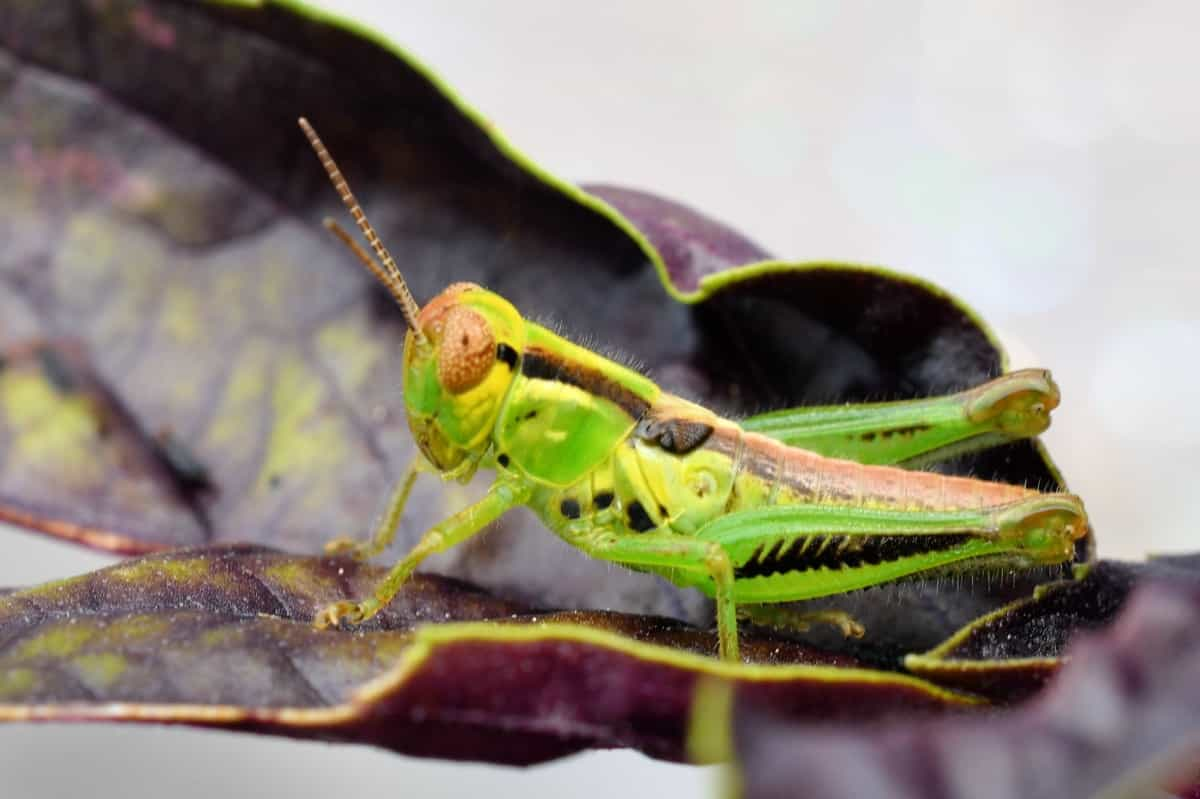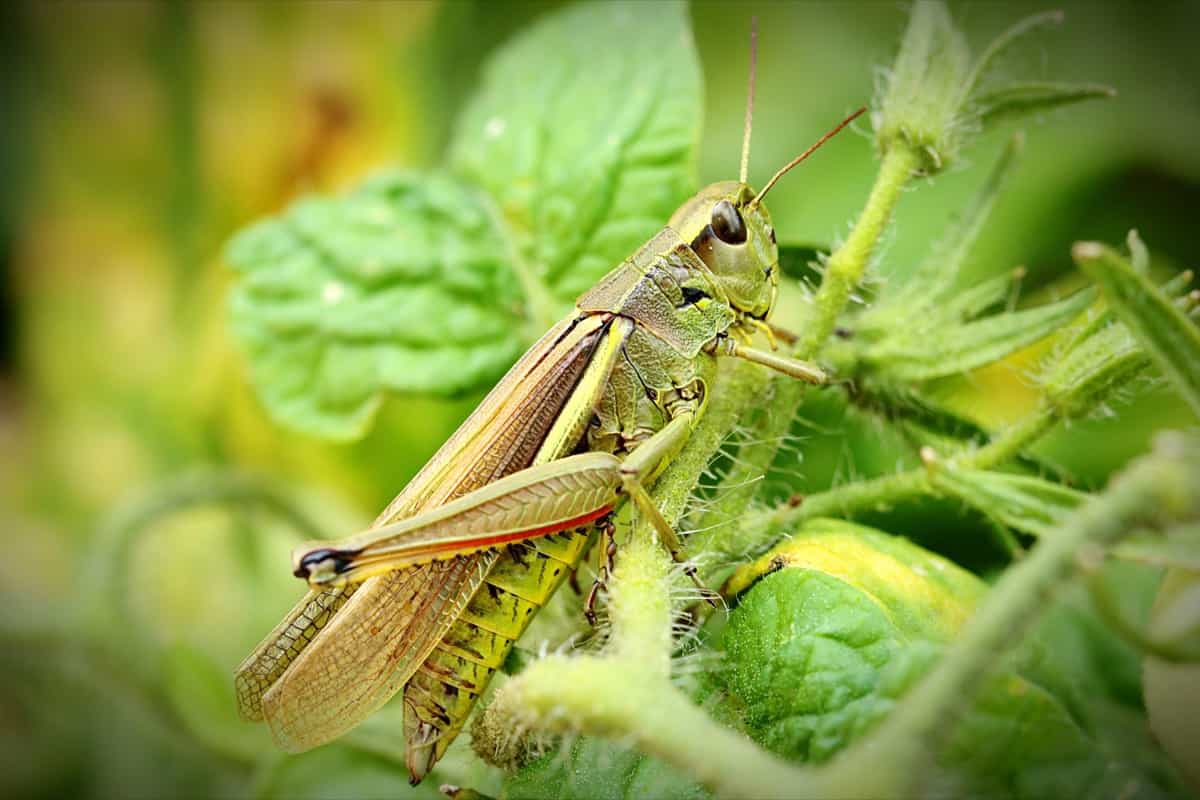Neem oil, extracted from the neem tree’s seeds (Azadirachta indica), is a versatile and natural solution for controlling grasshoppers on plants. Recognized for its eco-friendly properties, neem oil acts as a potent insecticide while remaining safe for plants, animals, and humans.

Its effectiveness lies in the presence of azadirachtin, a compound that disrupts the growth and feeding patterns of insects, making it an ideal alternative to chemical pesticides. This organic approach not only tackles grasshopper infestations but also supports sustainable and environmentally conscious gardening practices.
Neem Oil Application for Grasshoppers Control
Neem Oil and its Benefits for Grasshoppers
Neem oil presents a myriad of benefits in combating grasshopper infestations on plants. The key active ingredient, azadirachtin, works as a natural insect growth regulator, inhibiting the molting process and disrupting the feeding habits of grasshoppers. Moreover, neem oil acts as a repellent, deterring grasshoppers from settling on treated plants.
Its antifungal and antibacterial properties further contribute to the overall health of plants, promoting resilience against pest attacks. Unlike synthetic pesticides, neem oil poses minimal risk to beneficial insects, ensuring a balanced ecosystem in the garden. Additionally, its biodegradability minimizes environmental impact, aligning with sustainable gardening practices.
How to Prepare Neem Oil to Use on Grasshoppers
To effectively use neem oil for grasshopper control, follow these simple steps for preparation and application. Begin by acquiring pure neem oil, ensuring it is free from additives or synthetic compounds. Dilute two tablespoons of neem oil with a mild liquid soap or detergent in 4 liters of water. The soap helps emulsify the oil, ensuring proper dispersion. Shake the mixture vigorously to create a homogeneous solution. To apply, use a sprayer to cover both sides of the plant leaves, focusing on areas where grasshoppers are prevalent.
In case you missed it: Land Preparation Cost Per Acre: Exploring Different Cost Components

How to Apply Neem Oil on Grasshoppers
Start spraying the neem oil solution evenly over the plants, covering the upper and lower surfaces of leaves, stems, and other vulnerable areas where grasshoppers may reside. Pay particular attention to areas with visible grasshopper damage or signs of their presence. Ensure comprehensive coverage to create a protective barrier. Apply neem oil early in the morning or late in the afternoon when temperatures are moderate, and avoid treating plants during peak sunlight to prevent potential leaf burn.
Repeat the application every 7-14 days or as needed, especially after rain. Consistency is key, and a regular neem oil application routine will contribute to the reduction of grasshopper populations while promoting overall plant health. Monitor plant progress and adjust the frequency of application based on the severity of the infestation.
Mixing and Dilution for the Right Concentration of Neem Oil for Grasshoppers
Start by obtaining a pure neem oil product, ensuring it is free from additional additives. For a general neem oil solution, mix one to two tablespoons of neem oil with a mild liquid soap or detergent in a gallon of water. The soap aids in emulsifying the neem oil, allowing it to disperse evenly in the water. Thoroughly shake the mixture to ensure a well-blended solution before transferring it to a garden sprayer.
Adjust the Neemoil concentration based on the severity of the grasshopper infestation, but avoid exceeding the recommended dosage, as higher concentrations may not necessarily yield better results and could harm plants. Experiment with smaller batches first, observing how plants respond to the neem oil treatment. This allows for fine-tuning of the concentration to strike a balance between effective grasshopper control and minimal impact on the surrounding environment.
How Long Does Neem Oil Stay Effective on Grasshoppers?
Generally, neem oil remains active for about 7 to 14 days after application. This timeframe accounts for the oil’s residual effects on treated surfaces, acting as a deterrent and disruptor to grasshoppers. However, several factors influence the duration of neem oil’s efficacy. Rainfall or irrigation can wash away the oil, reducing its effectiveness, and environmental conditions such as extreme heat may accelerate its breakdown.
In case you missed it: How to Increase Yield from Container Gardens: Boost Plants Harvest with These Proven Strategies

Therefore, it’s advisable to reapply the neem oil solution after rain or significant watering, ensuring consistent coverage. For sustained grasshopper control, maintain a regular application schedule, repeating every 7 to 14 days or as needed, especially during periods of high grasshopper activity. Monitoring the garden for signs of grasshopper damage and adjusting the frequency accordingly helps to sustain neem oil’s effectiveness and promotes a thriving, pest-resistant environment.
Using Neem Oil Along with Other Pest Control Methods
Neem oil can be integrated with practices such as companion planting, attracting beneficial insects, and using physical barriers. Companion plants with natural repellent properties can complement neem oil’s effects, creating a less favorable environment for pests. Introducing beneficial insects like ladybugs or predatory beetles helps maintain a balanced ecosystem by preying on grasshoppers and other pests. Physical barriers, like row covers, can further protect plants from grasshopper feeding.
Some Common Pests and Diseases That Neem Oil Can Control on Grasshoppers
- Aphids: Neem oil disrupts the feeding and reproductive patterns of aphids, reducing their populations on plants.
- Whiteflies: The antifeedant properties of neem oil discourage whiteflies from settling on plant surfaces, helping to control their infestations.
- Caterpillars: Neem oil acts as a natural deterrent for caterpillars by disrupting their growth and feeding habits.
- Scale Insects: The suffocating effect of neem oil on insects helps control scale infestations, preventing further damage to plants.
- Fungal Diseases: This oil has antifungal properties that make it effective against diseases like powdery mildew and rust, which may occur alongside grasshopper infestations.
- Bacterial Infections: Neem oil’s antibacterial properties contribute to the control of bacterial diseases affecting plants.
- Leafhoppers: Neem oil disrupts the feeding and reproductive patterns of leafhoppers, offering additional control against these pests.
How to Monitor the Effectiveness of Neem Oil on Grasshoppers
- Visual Inspection: Regularly inspect plants for signs of grasshopper damage, such as chewed leaves and stems. Note any changes in the level of infestation over time.
- Grasshopper Population: Keep track of grasshopper populations in the garden. If their numbers decline after neem oil applications, it indicates the treatment’s efficacy.
- Plant Growth: Monitor overall plant health and growth. Neem oil promotes plant vigor by addressing not only grasshoppers but also other pests and diseases. Healthy, thriving plants suggest the effectiveness of neem oil.
- Reapplication Needs: Assess the need for reapplication based on environmental conditions, rainfall, and the frequency of grasshopper activity. If grasshoppers persist, adjust the application schedule accordingly.
- Companion Pest Control: If employing other pest control methods alongside neem oil, observe the interactions. A holistic approach with multiple control measures may enhance overall effectiveness.
In case you missed it: Pest Management in Balcony Gardens: Methods to Control Pests in Your Balcony

Safety Precautions to Take When Using Neem Oil on Grasshoppers
- Wear protective clothing, including hand gloves and eye protection, to avoid eye and skin contact with the concentrated solution.
- Choose a calm day for application to prevent drift and inhalation risks. Keep children and pets away from treated areas until the neem oil has dried completely.
- Follow the recommended dilution ratios specified on the product label to avoid over-application, as higher concentrations may harm plants.
- Store neem oil away from direct sunlight in a cool, dry place. If accidental contact occurs, rinse the affected area with plenty of water.
- As with any pesticide, read and follow the product label instructions carefully to ensure effective and safe use.
- Regularly assess the impact on non-target organisms and adjust application practices if necessary, always striving for a balanced and eco-friendly approach to grasshopper control.
Conclusion
In conclusion, utilizing neem oil for grasshopper control offers a natural and environment-friendly alternative to chemical pesticides. Its efficacy, coupled with benefits like plant health promotion and minimal impact on beneficial insects, makes neem oil a holistic solution. By integrating this natural remedy into gardening practices, one can foster a balanced ecosystem while effectively managing grasshopper infestations, promoting sustainable and thriving gardens.
- Feed Your Flock for Less: Top 10 Tips to Save on Chicken Feed
- Ultimate Guide to Ossabaw Island Hog: Breeding, Raising, Diet, and Care
- Hatching Answers: The Top 10 Reasons Your Chickens Aren’t Laying Eggs
- Eggs and Economics: Breaking Down the Cost of Raising Backyard Chickens
- Defend Your Greens: Proven Methods to Keep Iguanas Out of Your Garden
- Ultimate Guide to Cinnamon Queen Chicken: A Comprehensive Guide for Beginners
- Ultimate Guide to California Tan Chicken: Breeding, Raising, Diet, Egg-Production and Care
- Ultimate Guide to Marsh Daisy Chicken: Breeding, Raising, Diet, and Care
- 10 Types of Chicken Farming Businesses You Can Start for Profits